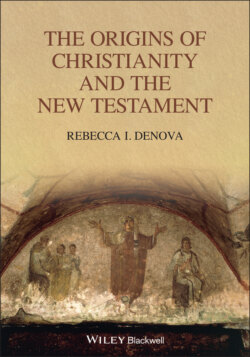Читать книгу The Origins of Christianity and the New Testament - Rebecca I. Denova - Страница 11
Features of this Textbook
ОглавлениеChapter I summarizes the post-Enlightenment approach to the study of the Bible and the three phases of “The Quest for the Historical Jesus” in the last century. The chapter also includes shared terminology and methodology in the study of ancient religions. Modern criteria for uncovering the “historical Jesus” are outlined in the first chapter.
Chapter II, “The History of Israel,” is a short history of Jews and Judaism, as revealed in the Jewish Scriptures. This history is crucial for positioning Jesus as a Jew in the first century. The gospels consistently call upon this history to frame the teachings of Jesus. Israel underwent a major paradigm shift after the conquests of Alexander the Great (330 bce). The cultural changes in this period are collectively known as “Hellenism” (after Hellas, the eponymous founder of Greece). These cultural elements are also incorporated into the New Testament.
The earliest texts of the New Testament are Paul’s letters, which were written in the 50s and 60s of the first century. Chronologically they should be placed prior to the gospels. However, most readers prefer to cover the story of Jesus in the gospels first; Paul provides very little information about the ministry. The second reason to examine Paul’s letters after the gospels is that he laid the groundwork for the later letters in the New Testament and what eventually became Christian dogma by the end of the first century.
After reviewing the history of Judaism up to the first century, Chapter III examines the first gospel in “The Gospel of Mark” (“The Apocalyptic Jesus”). We examine the way in which Mark structured his story in alignment with the Scriptures and the events of the Jewish Revolt (66–73 ce).
“The Gospel of Matthew” (The “New Moses”), Chapter IV, is perhaps the best-known of the gospels (particularly through the translation of the King James Bible in 1601). This chapter includes an exposition on the “nativity stories” of both Matthew and Luke (to avoid repetition later). Matthew also has the most “kingdom parables,” and we will examine these as they relate to Matthew’s portrait of Jesus.
Chapter V, “The Gospel of Luke” (“The Compassionate Jesus”), introduces the background of a two-volume work that is the longest document in the New Testament. It is also familiar for Luke’s unique parables (“The Good Samaritan” and “The Prodigal Son”). We explore the rationale for this opus and the unique ways in which Luke structured his story.
Chapter VI, “The Acts of the Apostles,” continues Luke’s story with this sequel to his gospel. Acts relates the progress of Christian missions as the message of Jesus was conveyed to the cities of the Eastern Roman Empire after his death.
The Stranger from Heaven, Chapter VII, differs significantly from the others in both style and structure. John’s preface is one of the most famous in the New Testament, coalescing the deification of Jesus that began shortly after his death. John’s gospel is the origin of the concept of “the Incarnation” of Jesus.
Chapter VIII, “Paul: Apostle to the Gentiles,” examines the way in which Paul contributed to Christian dogma with his arguments on how Christian believers could participate in “the Law of Moses,” and yet have a new identity. Often referred to as “the true founder of Christianity,” there are probably more books on Paul now than Jesus. One of the most complicated characters in the New Testament, Paul’s attitude toward Judaism continues to undergo modern analysis.
The details of Paul’s communities in Chapter IX (“Paul and the First Christians”) shed light on the first generation of Christians. We can appreciate some of the confusion of the first followers, as they were to live “like angels” until the return of Christ.
The other letters in the New Testament are examined briefly in Chapter X (“Other New Testament Documents”). They reveal changes in the communities from the middle to the end of the first century. These letters include a group known as “The Pastorals,” as they outline the initial hierarchy and structure (the election of bishops) and what became the institutional Catholic Church of the Roman Empire.
We end where the New Testament ends, with “John of Patmos and the Book of Revelation” in Chapter XI. One of the most famous (and infamous) books, the book still dominates Christian concepts of the return of Jesus (the “second coming”) and events that are to happen in “the final days.” The chapter provides a way in which to “decode” this strange book and the way in which to understand its symbols in historical context.
Each of the chapters places the documents within their historical context and highlights changes to the material over time.
